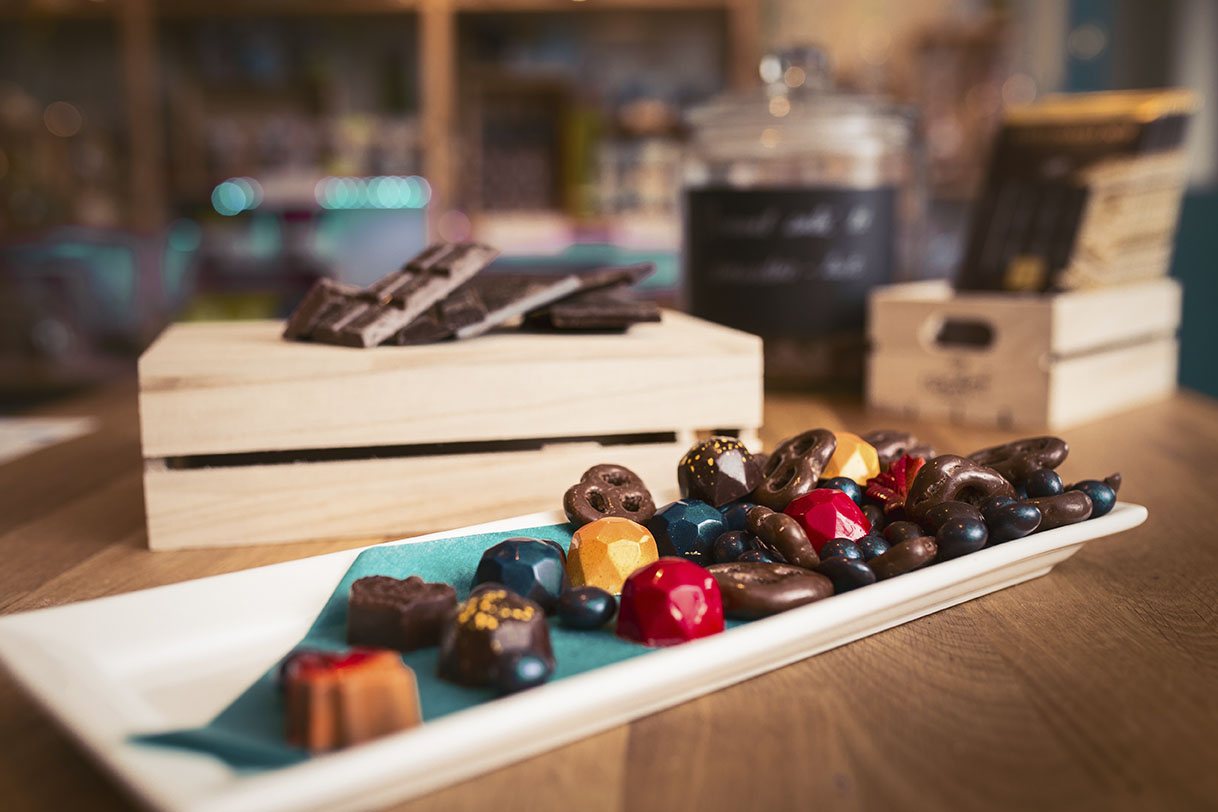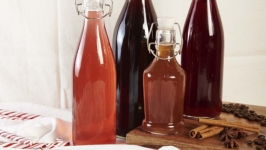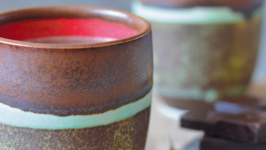Masters of "Chocolat" in the Outaouais
On a stormy late fall day when soggy leaves and sleet blow horizontally in equal measure and the crisp days of winter have not yet arrived, Christian Chaloin is getting into the holiday spirit, carefully painting chocolate figurines in the vibrant colours of Christmas. A dab of red here on Father Christmas’s coat, some green holly leaves there.
Chaloin, a fourth-generation chocolate-maker, is looking ahead to a busy holiday season when connoisseurs of fine chocolate make the pilgrimage to his store in Gracefield, Que., about an hour by car north of Gatineau.
Chaloin is a maître chocolatier or master chocolate-maker. It’s an official title bestowed upon those whose skills have been learned from, and passed down through, generations. His father and his grandfather before him have been chocolate-makers. His son, back in France, is a chocolate-maker. In 2021, the family will celebrate 100 years in the business. Chocolate runs in his veins.
“I used to work alongside my father after school every day from a very early age,” Chaloin explains. “I learned everything from him.”
“Everything” means chocolate from A to Z. Chaloin, who arrived from Annecy, France, several years ago after a philosophical difference with the direction the country was headed, initially settled in Gatineau. But shortly afterwards, he chose to move to the country, where he has the space and autonomy to craft his chocolates.
Boxes labelled Madagascar, Haiti, Colombia, Venezuela and a world tour of other countries line the shelves in his small production facility. He grabs a huge lump of yellow beurre de cacao, the fat content part of chocolate, the thing that makes it creamy and melt on your tongue. “This, this is the expensive stuff,” he says, waving the chunk. “I blend this with the finest cacao beans, purchased from all around the world, and then add as little sugar as possible.”
What? Yes, Maître Chaloin aims to use the least amount of sugar in his chocolates. He explains that the finer the quality of cacao beans, the less sugar one needs. Sugar needs rise as the quality of the beans drops, mostly to mask the slightly bitter, burnt taste left after roasting. His beans, he explains, are sourced by one of the best agents in France, someone who knows real quality.
It’s then up to Chaloin to find the balance for the flavours he aspires to create: a little bit of milk here, the smallest amount of sugar there, a touch of vanilla or maple syrup. He produces dozens of different varieties, including decadent dark chocolate truffles dusted with cocoa powder, creamily smooth on the tongue. Some feature maple syrup, salted caramel and vanilla. There are bars of nougat covered with dark chocolate, as well as animal figure lollipops in dark, milk and white varieties, strips of candied ginger and orange, decadently dipped in chocolate. For chocolate lovers, this is heaven. For lovers of sophisticated fine food, the shop walls glitter with luxurious chocolate boxes in a deep red colour, embossed with a crocodile skin pattern, all the better for presenting a precious gift.
For connoisseurs who like to compare their chocolate as they might wine, Chaloin offers simple bags of thin, broken-up bark pieces, in which the ingredients are minimal and the differing flavours are all about origin. Madagascar 100 per cent has only “love, cocoa butter and cacao beans,” while Dominican Republic features the same ingredients, but tastes quite different. He offers milk and white varieties, all with varying amounts of sugar, stevia, agave or no sweetener at all.
Béatrice et Chocolats
In a tiny jewel-box of a shop in Old Aylmer, Gaëtane Osborne produces a dizzying array of bijou chocolates. Osborne opened Béatrice et Chocolats, named after her grandmother, in May 2013 after a culinary journey all around the region. Following high school in Gatineau, she went to L’École Hôtelière de l’Outaouais in Buckingham to study restaurant service. But after a year, she knew she’d be happier in the kitchen, where, from a very young age, she’d always found herself at home.
After a stint making patisserie in Sainte-Adèle in the Laurentians, she worked in her boyfriend’s restaurant before taking the plunge to branch out on her own. Osborne knew what she was getting into — her parents are entrepreneurs. “Having grown up in a family business, I understand the endless hours of work, the things that can go wrong, the things out of one’s control, management and working with others,” she says. “None of these are secrets to me.” COVID-19, however, has thrown her little store a big curveball. Before the virus she used to have help, but now she’s all alone, cooking, creating and running the business. “I think I’m now working 100 hours a week,” she says with a grimace. She crafts her chocolates on Monday and Tuesday weekly, to then open the store from Wednesday through Saturday.
It takes three days to make a truffle. “You have to allow for the humidity to escape,” she explains. “Then that truffle is best eaten fresh, within 10 to 12 days. And you shouldn’t refrigerate it, because that will change the texture and taste. I make them in small quantities, with no preservatives, so that they’re always fresh,” Osborne says.
With that production method, she can also make flavours for special client requests. She has one particular client who loves mint, so she always makes sure there’s some on hand. Otherwise, her truffle flavours vary with the seasons and include things such as wintergreen, blueberries, vanilla, toffee, salted caramel and beer. “In seven years, I have never used the same beer twice,” she says. “Recently, I’ve used beer from the new microbrewery at the [end] of the street.”
Osborne starts her production with pastilles, imported from France. She then makes everything else by hand in her shop, tempering batches of white, milk and dark chocolate with differing sugar content to offer a wide range of conventional chocolate bars, with additions such as almonds, hazelnuts, hot pepper, blueberries and black fleur de sel in a white chocolate base. She crafts edible figurines for every season — masks and black cats for Hallowe’en, snowmen and Santas at Christmas. Eggs, of course at Easter. She also produces chocolate bark featuring pumpkin and sunflower seeds with crushed almonds, a white chocolate version with candied orange peel, amaretti biscuits and almonds. And the pièce de résistance? Chocolate bark with chips. “Perfect for a sweet-salty mix,” her website states.
Even though Osborne is restricted to just two customers at a time in her treasure trove of a store, “I have very faithful clients,” she says. “They’ve been incredibly supportive and understanding.”
Rochef Chocolatier
Roch Fournier founded Rochef in his mother’s basement in 2004. He was doing it all: at night, on weekends and a couple of days a week, he made chocolates. All the other hours, he manned his kiosk in a local shopping centre.
Rochef and Fournier have come a long way from that basement and the kitchen upstairs where he spent many hours as a kid making pies and cakes with his mother. Now housed in a large production facility in Gatineau, Rochef chocolates can be found in Farm Boy stores across the region, Costco stores across Quebec and a wide array of speciality stores across Ottawa-Gatineau. But despite the growing scale, this is still the company that Fournier founded, with his artistic vision and his passion for chocolate. He remains actively involved in the creation of new products.
For Fournier, it all became serious when he was given a copy of Larousse des Desserts for his 18th birthday. “I cooked through that whole book,” he recalls. “I did every recipe.”
During a stint working at the Casino de Hull, he got chatting with the chef in the staff canteen and asked where he might learn more about the art and practice of making chocolate. Under the tutelage of a master chocolate-maker in Saint-Hyacinthe, the hometown of chocolate company Barry Callebaut, he learned to make ganache, caramel, pâte de fruits, chocolate sculptures, crème pâtissière, among all the other skills needed for this sweet art.
Shortly after this, Fournier won a competition for Young Entrepreneurs of Quebec and set off for a month in Belgium and France. “That taught me so much,” he says, “it really opened my eyes to the possibilities and the creativity. It was a game-changer.
None of the Rochef products contains palm oil, a common ingredient in less premium chocolate, and they’re all gluten-free. “It was a big decision to choose not to use palm oil products,” Fournier says, “because it’s very inexpensive. But it’s bad for the environment, for taste and [it] also means that the chocolate contains little to no cocoa paste.” Fournier brings in his chocolate pastilles, from which he creates all his other products. “We’ve reached the size now that our customers expect consistency,” he explains. “We can’t have chocolate that varies widely in taste from one year to the next.” The Rochef blend is predominantly Peruvian, “because it has a lovely fruity taste,” says Fournier, who rounds his selection out with some from Ecuador and the Ivory Coast.
Cocoa beans, much like any other raw product, are highly reflective of their growing conditions. In 2008, there were fires in Cuba. “The following year, all the chocolate had a smoky taste,” Fournier explains. And while variables such as this may be just fine for a small artisan producer, larger customers expect consistency.
For Fournier, “the truffle defines a chocolate-maker. It’s here that you can really show your creativity and can play with flavours,” he says.
Rochef revises its truffle line every three years or so and has recently produced a collection of chocolates that sparkle like gem stones. There are orange and yellow truffles; blue truffles; white truffles speckled with dark chocolate; dark truffles speckled with orange; red truffles; green truffles and more.
In the 4,000-square-foot commercial kitchen in Gatineau, Christmas begins in late summer and Easter starts in December. Santa Claus and Christmas trees jostle for space with penguins and bear cubs, giving way to endless Easter bunnies. This year, Rochef staff will be delivering 20,000 of them to CVS Pharmacy in the U.S.
While the scale may be growing, details such as painting the hollow moulds “are all done individually by hand,” Fournier explains. “It’s really important to us that the details are right; that, for example, there’s sea salt on every bite of a chocolate bar. We inspect everything.”
Béatrice et Chocolats
101 Rue Principale, Vieux-Aylmer, Que.
beatriceetchocolats.ca | 819.557.1884 | @beatriceetchocolats
MC Chaloin
19 Rue Saint Joseph, Gracefield, Que.
819.463.1946
Rochef Chocolatier
81 Jean Proulx St., Gatineau, Que.
rochef.ca | 819.205.0533 | @rochefchocolatier











